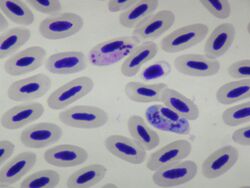Biology:Haemoproteus columbae
From HandWiki
Short description: Species of blood parasite
| Haemoproteus columbae | |
|---|---|
| Scientific classification | |
| Domain: | Eukaryota |
| Clade: | Diaphoretickes |
| Clade: | SAR |
| Clade: | Alveolata |
| Phylum: | Apicomplexa |
| Class: | Aconoidasida |
| Order: | Chromatorida |
| Family: | Haemoproteidae |
| Genus: | Haemoproteus |
| Species: | H. columbae
|
| Binomial name | |
| Haemoproteus columbae Kruse, 1890
| |
Haemoproteus columbae is a species of blood parasite related to Plasmodium and other malaria parasites.[1]
Phylogenetic relationships among the Haemosporidia
Haemoproteus columbae is a true member of the genus Haemoproteus, basal to other avian Parahaemoproteus species.[2] Parahaemoproteus species have been subsequently split from Haemoproteus and are recognized as their own genus, sister to Plasmodium malaria parasites.[3]
Transmission
Haemoproteus columbae is transmitted by the pigeon louse fly, Pseudolynchia canariensis.
Pathology or host effects of infection with H. columbae
Haemoproteus columbae infects pigeons. It is usually benign and does not reduce survival of its host.[4] However, it can sometimes be fatal to young pigeons.[5]
It is slated for genome sequencing.[6]
References
- ↑ Cox FE (2010). "History of the discovery of the malaria parasites and their vectors". Parasites & Vectors 3 (1): 5. doi:10.1186/1756-3305-3-5. PMID 20205846.
- ↑ Toscani Field, Jasper; Weinberg, Josh; Bensch, Staffan; Matta, Nubia E.; Valkiūnas, Gediminas; Sehgal, Ravinder N. M. (2018). "Delineation of the Genera Haemoproteus and Plasmodium Using RNA-Seq and Multi-gene Phylogenetics". Journal of Molecular Evolution 86 (9): 646–654. doi:10.1007/s00239-018-9875-3. ISSN 1432-1432. PMID 30426144. Bibcode: 2018JMolE..86..646T.
- ↑ Martinsen, Ellen S.; Perkins, Susan L.; Schall, Jos J. (2008-04-01). "A three-genome phylogeny of malaria parasites (Plasmodium and closely related genera): Evolution of life-history traits and host switches". Molecular Phylogenetics and Evolution 47 (1): 261–273. doi:10.1016/j.ympev.2007.11.012. ISSN 1055-7903. PMID 18248741.
- ↑ Knutie, Sarah A.; Waite, Jessica L.; Clayton, Dale H. (2013). "Does avian malaria reduce fledging success: an experimental test of the selection hypothesis" (in en). Evolutionary Ecology 27 (1): 185–191. doi:10.1007/s10682-012-9578-y. ISSN 0269-7653. http://link.springer.com/10.1007/s10682-012-9578-y.
- ↑ Markus, Miles B.; Oosthuizen, J.H. (1972). "Pathogenicity of Haemoproteus columbae" (in en). Transactions of the Royal Society of Tropical Medicine and Hygiene 66 (1): 186–187. doi:10.1016/0035-9203(72)90072-7. PMID 4625895. https://academic.oup.com/trstmh/article-lookup/doi/10.1016/0035-9203(72)90072-7.
- ↑ "From Original "Table 2 Summary of Malaria Sequencing Completed or Planned"". Plasmodium Genomics Resource. http://plasmodb.org/plasmo/communityDownload.do?fname=Table2_021208_SampleStatus_032111%20SampleStatus.pdf. Retrieved 26 April 2015.
Wikidata ☰ Q16969506 entry
 |


